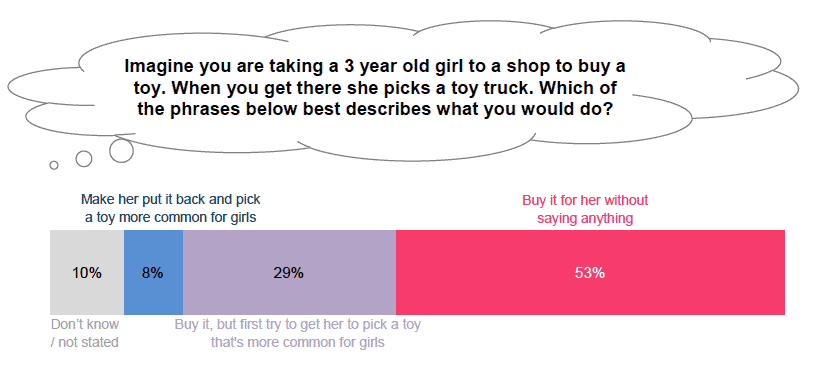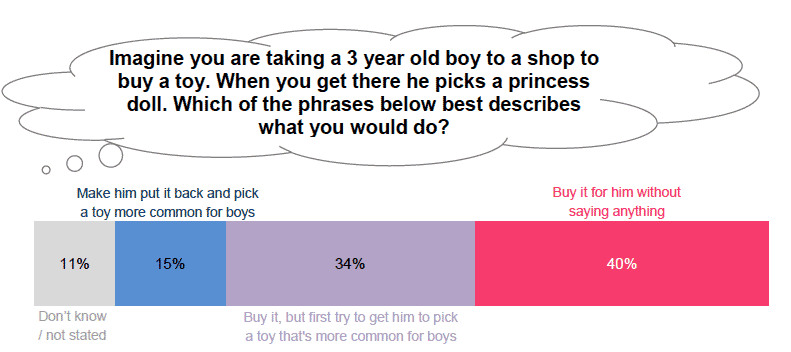Young People's Attitudes To Violence Against Women Report On Findings From The Young People In Scotland Survey 2014
Findings from the 2014 Young People In Scotland survey on the attitudes of young people (aged 11-18) to violence against women.
Young people's attitudes
Domestic abuse - physical violence
When presented with a scenario involving physical violence, more than a third (36%) of young people thought the man's behaviour in this scenario was 'very seriously wrong' ( i.e. from a scale of 1-7, where 1 means "not wrong at all" and 7 means "very seriously wrong", 36% chose 7 as their response). Over two thirds (69%) chose a response from the 'seriously wrong' end of the scale (5, 6 or 7).
Around a third (34%) of young people thought the man's wife should forgive him if he apologised immediately, while almost a half (46%) thought she should not forgive him.

On a scale of 1-7, where 1 means 'not wrong at all' and 7 means 'very seriously wrong', please choose the number which best describes what you think about the man's behaviour

What if he immediately told her how sorry he is for slapping her, do you think she should forgive him?

Domestic abuse - controlling behaviour
When presented with a scenario involving controlling behaviour (a man trying to stop his wife going out with friends), this tended to be viewed as less serious than physical violence. Around a fifth (21%) of young people thought the man's behaviour was 'very seriously wrong' (compared with 36% for physical violence), although 65% chose a response from the 'seriously wrong' end of the scale (compared to 69% for physical violence).
The majority (76%) of young people thought the controlling behaviour would cause the woman at least some harm (as opposed to 'not very much' or 'none at all').

On a scale of 1-7, where 1 means 'not wrong at all' and 7 means 'very seriously wrong', please choose the number which best describes what you think about the man's behaviour.

What harm, if any, do you think this does to her?

Stalking and harassment
Three specific types of stalking and harassment behaviours were asked about: stalking by an ex-boyfriend (in the form of being sent unwanted gifts and flowers), being wolf-whistled at by a group of strangers and posting naked photos online of someone else.
Only a very small minority (7%) of young people viewed the scenario of being sent unwanted flowers and gifts by an ex-boyfriend as being very seriously wrong, although over a third (36%) gave a response from the right hand side of the scale (5, 6 or 7), indicating that they considered it wrong to some extent. Over half (58%) of young people felt that this behaviour would cause at least some harm (as opposed to 'not very much' or 'none at all').

On a scale of 1-7, where 1 means 'not wrong at all' and 7 means 'very seriously wrong', please choose the number which best describes what you think about the man's behaviour.

What harm, if any, do you think this does to her?

Compared to receiving unwanted gifts from an ex-boyfriend, young people were more likely to view being wolf-whistled at by a group of strangers as very seriously wrong (14%). Over half (54%) considered this to cause at least some harm (as opposed to 'not very much' or 'none at all').

On a scale of 1-7, where 1 means 'not wrong at all' and 7 means 'very seriously wrong', please choose the number which best describes what you think about the men's behaviour.

What harm, if any, do you think this does to her?

Young people saw putting naked photos of an ex-girlfriend online as being much more serious than either of the other stalking and harassment behaviours asked about. Over three quarters of young people felt that posting photos of an ex-girlfriend online was 'very seriously wrong' and would cause 'a great deal' of harm.
The majority (80%) of young people believed that posting naked photos of an ex-girlfriend online should be illegal. [1]

On a scale of 1-7, where 1 means 'not wrong at all' and 7 means 'very seriously wrong', please choose the number which best describes what you think about the man's behaviour.

What harm, if any, do you think this does to her?

Should putting naked photos of an ex-girlfriend online be against the law?

Commercial sexual exploitation
Commercial sexual exploitation includes a wide range of often linked sexual activities which (typically) men profit from or buy from women and which objectify and harm women. It includes prostitution, phone sex, internet sex/chat rooms, stripping, pole dancing, lap dancing, peep shows, pornography, trafficking, sex tourism and mail order brides [2] .
Young people were asked about two forms of commercial sexual exploitation, magazines featuring topless women and strip clubs. Young people tended to view these as much less serious than the other forms of violence against women they were asked about.
Just under a third (30%) of young people thought it was 'not wrong at all' for an adult to read magazines that feature topless women, compared to 4% who thought it was 'very seriously wrong'.
A quarter (25%) of young people thought it was 'not wrong at all' for a group of men to go to a strip club to watch naked women, while 7% thought it was 'very seriously wrong'.
How wrong do you personally think it is for an adult (18 or over) to read magazines that feature topless women, or is it not wrong at all?

How wrong do you personally think it is for a group of men (18 or over) to go to a strip club to watch naked women, or is it not wrong at all?

Gender stereotypes
Stereotypical views on gender roles exist amongst young people in Scotland - as demonstrated by their willingness, or otherwise, to buy a small child a toy that is not traditionally associated with the child's gender.
Just over half (53%) of young people stated that, if a 3 year old girl chose a toy truck in a toy shop, they would buy it for her without saying anything. However, a further 29% would buy it for her only after trying to get her to pick a toy that's more common for girls, while 8% would make her put it back and choose a toy more common for girls.
Young people were even less willing to buy a non-stereotypical toy for a boy than for a girl. Well below half (40%) of them stated they would buy, without saying anything, a princess doll for a 3 year old boy who had chosen it, 34% would buy it only after trying to get him to pick a toy that is more common for boys and 15% would make him put it back.


Contact
There is a problem
Thanks for your feedback